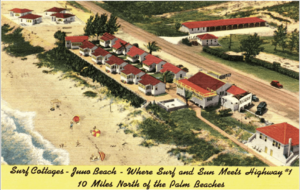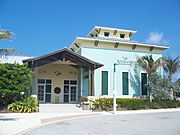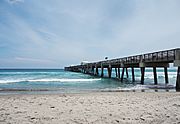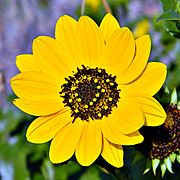Juno Beach, Florida facts for kids
Quick facts for kids
Juno Beach, Florida
|
||
|---|---|---|
| Town of Juno Beach | ||
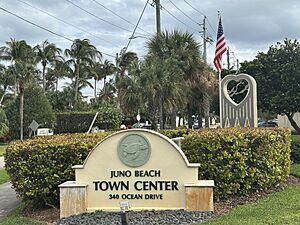 |
||
|
||

Location of Juno Beach in Palm Beach County, Florida
|
||
| Country | ||
| State | ||
| County | ||
| Incorporated | 1953 | |
| Government | ||
| • Type | Council-Manager | |
| Area | ||
| • Total | 2.72 sq mi (7.05 km2) | |
| • Land | 2.04 sq mi (5.28 km2) | |
| • Water | 0.68 sq mi (1.77 km2) | |
| Elevation | 23 ft (7 m) | |
| Population
(2020)
|
||
| • Total | 3,858 | |
| • Density | 1,892.10/sq mi (730.39/km2) | |
| Time zone | UTC-5 (Eastern (EST)) | |
| • Summer (DST) | UTC-4 (EDT) | |
| ZIP code |
33408
|
|
| Area code(s) | 561, 728 | |
| FIPS code | 12-35850 | |
| GNIS feature ID | 0284999 | |
Juno Beach is a small town located in Palm Beach County, Florida, United States. It's known for being home to the main office of Florida Power & Light, the Loggerhead Marinelife Center (a sea turtle hospital), and the Seminole Golf Club. Long ago, it was even the first county seat for the area that was then called Dade County.
Juno Beach is part of the larger Miami metropolitan area. The town was officially started in 1953. In 2020, about 3,858 people lived there.
Contents
History of Juno Beach
Juno Beach got its name from ancient Roman mythology. It was named after Juno, the wife of Jupiter. This happened because a nearby town to the north was named Jupiter. The name was chosen sometime in the 1800s.
A pier was built in Juno Beach in 1946. The town's layout was planned in 1948. Then, in 1953, Juno Beach officially became a town. The first pier was damaged in a big storm in 1984. A new, longer pier was built in 1999. It is 993 feet long.
Juno Beach During World War II
During World War II, German submarines, called U-boats, patrolled the coastline near Juno Beach. They often targeted oil tankers. These tankers carried oil using the fast Gulf Stream current, which flows close to the south Florida coast.
People worried that the quiet coastline would be a good place for German spies or saboteurs to land. To prevent this, a special beach patrol was formed. Men on horseback rode along the beach to watch for any enemy activity. Sometimes, wounded American sailors whose ships had been sunk by submarines were found on the beach. Local townspeople would quickly take them to the hospital.
The U.S. Coast Guard used the Surf Cottages motel during the war. The motel's car sheds across the street were used as stables for the horses. Civilian volunteers also helped with the horseback beach patrols.
Geography of Juno Beach
Juno Beach is located at 26°52′24″N 80°3′15″W / 26.87333°N 80.05417°W. The town covers about 1.9 square miles (4.9 square kilometers). About 25% of this area is water.
Climate in Juno Beach
Juno Beach has a warm, tropical climate. It gets a lot of sunshine throughout the year. Summers are hot and humid with frequent thunderstorms. Winters are mild and dry, making it a popular place to visit.
Population of Juno Beach
| Historical population | |||
|---|---|---|---|
| Census | Pop. | %± | |
| 1960 | 249 | — | |
| 1970 | 747 | 200.0% | |
| 1980 | 1,142 | 52.9% | |
| 1990 | 2,121 | 85.7% | |
| 2000 | 3,262 | 53.8% | |
| 2010 | 3,176 | −2.6% | |
| 2020 | 3,858 | 21.5% | |
| U.S. Decennial Census | |||
In 2020, the town of Juno Beach had a population of 3,858 people. There were 2,334 households and 943 families living in the town.
Fun Places to Visit
- Juno Dunes Natural Area: A beautiful natural area with walking trails and coastal habitats.
- Loggerhead Park and Loggerhead Marinelife Center: A park with beach access and a famous center that rescues and rehabilitates sea turtles.
See also
 In Spanish: Juno Beach para niños
In Spanish: Juno Beach para niños




